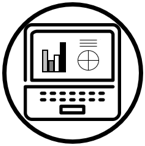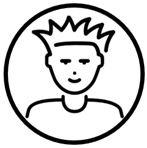We first introduced the CIA of Blended Learning: digital Curriculum, guided Instruction, and authentic Assessment for a blended learning environment with these unique qualifiers. The more we present this concept to teachers, schools, and administrators it has grown and expanded to show the entwined relationship of the three elements.
To help educators see the interconnected CIA relationships [Technology – Teacher – Student], we have an easy one-third balanced blended framework. Understanding the one-third relationship of the three elements shifts the teacher’s mindset towards partnering with digital content and releasing learning to students in active engagement settings.
We challenge educators to rethink their role as a facilitator who is intentionally “off the stage” two-thirds of the time. We like to call this two-thirds time ‘teaching by walking around,’ which leads to stronger teacher-student relationships. This one-third balance isn’t just a framework—it’s a mindset shift that empowers students, leverages technology, and fosters deeper learning.
Blended Learning Defined
First, let’s revisit the definition of blended learning, in its simplest of terms: Adding the wisdom of teachers, with the intelligence of technology to create a personalized learning environment for every student. Understanding the relationship of these three elements helps to create a balanced blended classroom.
The three icons above; technology, teacher, and students, create the one-third framework.
Digital Curriculum: One-Third Technology
In a blended classroom, teachers need to partner with software and the intelligence of technology, which can provide individual data points, to deliver Depth of Knowledge (DOK) levels 1-2: recall and skill/concept. Computer access to lessons allows students to pick up where they left off, thus reducing gaps in learning.
- Engaging digital software

- Aligned to standards
- Personalized learning space
- Data points for every individual student
Through partnering with digital content, software and resources filled with curriculum with individual data points, teachers are freed from having to deliver DOK 1-2 to the masses.
Guide Instruction: One-Third Teacher
Using the data from the digital partner, the wisdom of the teacher can support and extend learning. When teachers partner with software, they no longer have to lecture to the middle, they can create learning environments that intervene (DOK 1-2) where necessary and stretch students to Depth of Knowledge (DOK) level 3: strategic thinking.
- Data-driven

- Small and whole group
- Scaffold, support, and stretch
- Emphasis on power/essential standards
- Guided student-centered learning via playlist or choice boards and menus
Teachers know where students typically stumble or have misconceptions and what standards are essential. This wisdom is vital in the blended classroom. Large group instruction may be used to expand on standards or as a method to open and close digital lessons, sandwiching the learning. But keep in mind, students also want a relationship with their teacher, so one-on-one tutoring and small groups provide valuable time with individual students.
Authentic Assessment: One-Third Student
Both the digital curriculum and the teacher-guided instruction will assess students, so in a blended classroom, using digital tools, students should be assessed via the Four Cs and project learning. This type of assessment extends learning to Depth of Knowledge (DOK) level 4: extended thinking and active engagement with peers using the Four Cs:
Students can demonstrate their mastery of standards via teamwork and project learning, all the while building upon much- needed durable skills like time management and leadership.
Putting it All Together
The one-third relationships of the foundations of CIA of Blended, help teachers in planning balanced learning environments. Digital Curriculum provides DOK 1-2. With data. teachers provide guide Instruction, to intervention as needed and stretch learning to DOK 1-3. Teachers extend the learning via authentic Assessment. Utilizing the four C’s and the technology tools, students demonstrate mastery of curriculum standards.
Share your thoughts on Twitter at #CIAofBlended



